Abstract
One of the pre-Jurassic metamorphic basements of the Western Sakarya Zone (NW Turkey) is the Havran Unit which contains metasedimentary (i.e. the Kalabak formation) and metaintrusive rocks of Devonian age. An LA-ICP-MS U-Pb zircon dating study was conducted on 125 zircon grains obtained from a metasedimentary rock to better understand the origin and evolution of the Kalabak formation. Around 107 of 175 spot analyses are concordant with rates 90–110% and the zircon ages vary between 426 ± 5.2 and 3406.9 ± 195.7 Ma. Zircon populations cluster in ranges: 426 ± 5.2–535 ± 13 Ma (8.4%, Palaeozoic), 549 ± 14–999 ± 11 Ma (54.21%, Neoproterozoic), 1012 ± 200–1543 ± 50 Ma (6.54%, Mesoproterozoic), 1736 ± 123–2414 ± 58 Ma (18.7%, Palaeoproterozoic), and 2512 ± 30–3406.9 ± 195.7 Ma (12.15%, Archean). Dominating Neoproterozoic ages notate Cadomian-Avalonian terrains and Mesoproterozoic ages should mainly be related to Avalon terrains. The Karacabey metagranite consists of coarse-grained, equigranular, hypidiomorphic, and rarely foliated monzogranite and granodiorite. It is located to the north of the town of Karacabey in the eastern part of the Biga Peninsula. Main mineral assemblage is quartz, K-feldspar, plagioclase, and biotite. Zircon, apatite, monazite, magnetite, and sphene occur as accessory phases. Aluminum Saturation Index (ASI) values vary between 0.91 and 1.63, indicating the pluton as a metaluminous-peraluminous, I-type granite. The metagranite samples are plotted in the high-K-calcalkaline field on the SiO2 vs. K2O diagram. N-MORB-normalised spidergrams display a profound enrichment in the large-ion lithophile elements (LILE), light rare earth elements (LREE), and depletion in high field strength elements, suggesting that its genesis relates to hydrous melting of a mantle wedge in a subduction zone and/or melting of subduction zone-influenced source areas. Chondrite-normalised rare earth element spidergrams are indicative of the importance of plagioclase and amphibole fractionation. In tectonic discrimination diagrams, all of the metagranite samples fall into the volcanic arc granite and late post-collisional granite fields. U/Pb LA-ICP-MS zircon dating of the metagranite yielded an age of 400.3 ± 1.4 Ma (Early Devonian), interpreted as the age of igneous crystallisation. These age data show that the Karacabey metagranite is a member of the lower to mid Devonian granites, recently described from the Biga Peninsula. In light of these findings, we argue that the Havran Unit was an exotic terrain which possibly was once a part of far-travelled Avalon terrains and was attached to Sakarya Zone.
1. Introduction
Detrital zircon ages obtained from metasedimentary rocks provide important clues for the determination of potential source regions of exotic terrains in orogenic belts such as Western Anatolia where many discrete continental blocks once located far away from each other and divided by the oceans joined together. In addition, detrital zircon ages are very useful tools for understanding the origins of metamorphosed and fossil-free rocks. Moreover, dating of cross-cutting plutonic rocks can be combined with the ages of detrital zircons to provide additional information on the timing of deposition (Condie, Belousova, Griffin, & Sircombe, Citation2009; Kolodner et al., Citation2006; Linnemann et al., Citation2011; Morag, Avigad, Gerdes, Belousova, & Harlavan, Citation2011; Strachan et al., Citation2007; Talavera, Montero, Martínez Poyatos, & Williams, Citation2012; Ustaömer, Ustaömer, & Robertson, Citation2012).
The Havran Unit is composed of metasedimentary rocks (i.e. the Kalabak formation) intercalated with ultramafic and metavolcanic rocks, and cross-cutting Devonian metagranites (i.e. the Yolindi, Çamlık, and Karacabey metagranites; Aysal et al., Citation2012 and references therein; Aysal & Peytcheva, Citation2012). In the Biga Peninsula, basement rocks (Havran Unit) are mapped as the Kalabak or Torasan formations (or units) in different areas by several researchers (Duru, Pehlivan, Dönmez, Ilgar, & Akçay, Citation2007; Duru, Pehlivan, Okay, Şentürk, & Kar, Citation2012; Krushensky, Akçay, & Karaeğe, Citation1980; Okay, Siyako, & Bürkan, Citation1991; Pickett & Robertson, Citation1996; Robertson & Ustaömer, Citation2011). Although the Havran Unit is exposed in a large area from Havran (western Biga Peninsula) to the town of Karacabey (located in the east of the Biga Peninsula), its origin and relationship with other units remained ambiguous until now within the Central Sakarya basement.
For the first time, we obtained LA-ICP-MS U-Pb zircon ages from both the metasedimentary rock sample (i.e. detrital zircon ages from the Kalabak formation) and cross-cutting metaintrusive rocks (i.e. the Karacabey metagranite). In this paper, we evaluate the detrital zircon ages obtained from the Kalabak formation with special reference to potential source regions of the Havran Unit and discuss their relationships with other continental blocks (e.g. Central and Eastern Sakarya, Istanbul, and Istranca zones) in Turkey and in the eastern Mediterranean region. Geochemistry and petrology of the Devonian Karacabey metagranite is presented and compared with other two metagranites of the Havran Unit (i.e. the Çamlık and Yolindi metagranites) described previously by Aysal et al. (Citation2012) in Biga Peninsula.
Cadomian–Avalonian belts were formed along the northern margin of Gondwana and represent an over 5.000-km-long continental margin arc, comparable in size with that of the modern Andes (Ustaömer, Collins, & Robertson, Citation2009). Cadomian–Avalonian terrains have recently been described from Western Pontide in the basement complexes of the Istanbul Zone (Ayda Ustaömer, Mundil, & Renne, Citation2005; Ustaömer, Citation1999), in the Zonguldak – Karadere area (Chen, Siebel, Satır, Terzioğlu, & Saka, Citation2002), in the Armutlu metamorphics, NW Turkey (Akbayram, Okay, & Satır, Citation2012; Okay et al., Citation2008a).
2. Geological settings
Turkey resembles a geological puzzle where various microcontinental blocks were attached to each other during geological times (Figure ). Among these, the most important piece of this puzzle is the northwestern Anatolia sector which is composed of numerous distinct tectonic units derived from different continental and oceanic crustal fragments (Ketin, Citation1966; Okay & Tüysüz, Citation1999).
Figure 1. Tectonic map of Turkey and surrounding area with major suture zones (Okay & Tüysüz, Citation1999; http://giseurope.brgm.fr/Tethyan/WTethysideMed2.gif). IPS: Intra Pontide suture, IAES: Izmir-Ankara-Erzincan suture, ITS: Inner Tauride suture.
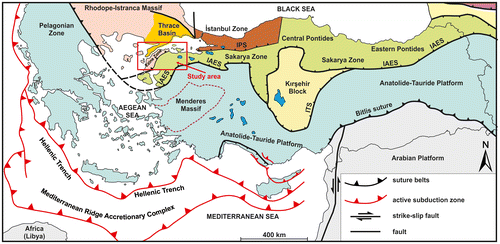
The Izmir-Ankara-Erzincan-Suture (IAES) belt is the main suture zone between the continental blocks that separates the Pontides in the north from the Anatolide–Tauride platforms in the south (Şengör & Yılmaz, Citation1981). The Pontides are made up of three significant continental blocks which are named the Istranca (Strandja) Massif, Istanbul, and Sakarya zones (Ketin, Citation1966; Okay, Citation1989, Citation2000; Okay & Tüysüz, Citation1999) in NW Turkey. The Istranca Massif consists of Upper Precambrian to Lower Cretaceous intrusives and sedimentary rocks metamorphosed in greenschist and amphibolite facies, and Istanbul Zone is composed of Precambrian metamorphic rocks overlain by Lower Ordovician–Lower Carboniferous sedimentary rocks (Chen et al., Citation2002; Okay, Satır, Tüysüz, Akyüz, & Chen, Citation2001; Sunal, Natal’in, Satır, & Toraman, Citation2006; Sunal, Satır, Natal’in, & Toraman, Citation2008; Yılmaz-Şahin, Aysal, Güngör, Peytcheva, & Neubauer, Citationin press). Remaining part of Pontides is described as Sakarya Zone (Ketin, Citation1966; Okay & Tüysüz, Citation1999) and/or Sakarya composite terrain (Göncüoğlu, Dirik, & Kozlu, Citation1997). Sakarya Zone includes Liassic to Upper Cretaceous sedimentary rocks and a pre-Jurassic metamorphic basement (Okay & Tüysüz, Citation1999). Sakarya Zone is bounded by the Ezine Zone in western Biga peninsula. Ezine Zone is made up of Upper Cretaceous ophiolitic mélange (i.e. Çetmi mélange, Beccaletto, Bonev, Bosch, & Bruguier, Citation2007; Okay, Siyako, & Burkan, Citation1991), metasedimentary rocks including blueschist and eclogite lenses (the Çamlıca Metamorphics; Okay, Citation2000; Okay et al., Citation1991).
Pre-Jurassic basement of Sakarya Zone is formed by a series of metamorphic massifs and enigmatic continental blocks (i.e. Pulur Massif, Topuz et al., Citation2010; and Karadağ Metamorphics, Ustaömer, Robertson, Ustaömer, Gerdes, & Peytcheva, Citation2012 in Eastern Pontides; Kazdağ and Uludağ massifs; Cavazza, Okay, & Zattin, Citation2008; Duru et al., Citation2007, Citation2012; Okay et al., Citation2008a in Western Pontides).
Ages obtained from Central Sakarya and Eastern Pontides indicate that Peri-Gondwanan terrains were accreted to southern Eurasia and cross-cut by Carboniferous granites bearing arc signature (Topuz et al., Citation2010; Ustaömer, Robertson, et al., Citation2012; Ustaömer, Ustaömer, et al., Citation2012).
The most common rocks in Sakarya Zone are the subduction accretion complexes of Permian–Triassic age, which were formed by north-dipping subduction of the Palaeotethys under the southern Eurasia (i.e. the Karakaya Complex: Okay, Citation2000; Okay & Göncüoğlu, Citation2004; Pickett & Robertson, Citation1996, Citation2004; Robertson & Ustaömer, Citation2011; Robertson et al., Citation2004). The Karakaya Complex is observed throughout the whole length of northern Turkey from the Biga Peninsula in the west to Artvin (eastern border of Turkey) in the east (Figure ). The Karakaya Complex consists of two units: (1) the Lower Karakaya which is represented by high-grade metamorphics and (2) the Upper Karakaya which is made up of lower-grade metamorphics (Okay & Göncüoğlu, Citation2004). The Lower Karakaya Unit corresponds to the Nilüfer Unit which is represented by metabasites and metacarbonates. Upper Karakaya Unit is divided into three subunits: (i) MORB-type pillow lavas, metachert, and turbiditic sandstones (Ortaoba Unit), (ii) Devonian radiolarian ribbon cherts as olistoliths and as thin (<100 m) tectonic slices, Carbonifeous limestones blocks and sediments representing debris flows (Orhanlar graywacke), (iii) within plate volcanics (Çal Unit) and arkosic sandstone conglomerates including Carboniferous–Permian limestones (Hodul Unit; Okay & Göncüoğlu, Citation2004; Pickett & Robertson, Citation2004; Robertson & Ustaömer, Citation2011).
The fourth basic unit of Sakarya Zone is the Havran Unit which is made up of lower to middle-grade metasedimentary rocks (i.e. the Kalabak formation) and cross-cutting Devonian plutonic rocks (Aysal et al., Citation2012; Okay, Satır, & Siebel, Citation2006; Okay et al., Citation1991; Figure (A)). The Kalabak formation and the Devonian metagranites (i.e. Yolindi and Çamlık metagranites) were described previously in detail by Aysal et al. (Citation2012). This study basically focuses on the Havran Unit, extending to the NE, and being cross-cut by the Devonian Karacabey metagranite in the north of the town of Karacabey (Aysal & Peytcheva, Citation2012; Pehlivan, Duru, Kanar, & Kandemir, Citation2011).
Figure 2. (A) Simplified geological map of the Biga Peninsula and surroundings showing the distribution of tectonic zones discussed in the paper (after Duru et al., Citation2007, 2012; Pehlivan et al., Citation2011). (B) Geological map of the study area (in the eastern Karacabey Town, continuation of the contacts of Havran Unit is taken from Pehlivan et al., Citation2011; tectonic contact between the Havran and Nilufer units in the north of the Karacabey pluton is taken from Sunal, Citationin press).
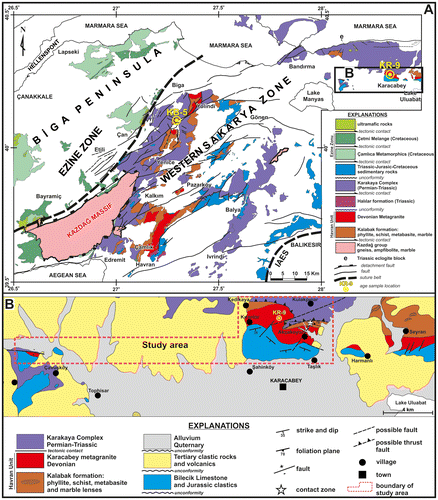
There are a number of Eocene to Oligo–Miocene volcanic and plutonic rocks across the Biga Peninsula which reflect post-collisional magmatic activity resulting from the collision of the Sakarya Zone with the Anatolide–Tauride Platform during the Late Palaeocene–Early Eocene period (Aldanmaz, Pearce, Thirlwall, & Mitchellal, Citation2000; Altunkaynak, Citation2007; Altunkaynak & Dilek, Citation2006).
2.1. Geology of Karacabey area
The oldest rocks of the Karacabey area are made up of regionally metamorphosed metaclastic successions with subordinate metacarbonate-metachert-metabasites, intercalated with tectonic slices of metaserpentinites which were named as the Fazlıkonağı formation (Ergül, Gözler, Akçaören, & Öztürk, Citation1986). These are correlated with the Kalabak formation and also considered as the continuation of the Kalabak formation across the NE part of the Biga Peninsula. This formation is composed mainly of dark-gray quartz-muscovite-albite schists, andalusite-bearing quartz-biotite schists, micaschist, and phyllite. Bands and lenses of marble are locally observed in this formation.
Okay (1988) described the overlaying basic metamorphic rocks as the Sazak formation and considered that these units are vertically and laterally transitional to the Kalabak formation (Duru et al., Citation2007, 2012; Pehlivan et al., Citation2011). Okay et al. (Citation1991) renamed the Sazak formation as the Nilüfer Unit and this new name has been extensively used by most researchers. However, the inferred transitional contact relation of the Nilüfer Unit with the Kalabak formation was reinterpreted as tectonic contacts (Robertson & Ustaömer, Citation2011).
In the study area, the Kalabak formation is tectonically overlain by the Nilüfer Unit of Lower Karakaya Complex (Sunal, Citationin press). Glaucophane-chlorite schists and glaucophane-epidote schists are exposed in the N-NW direction of the Karacabey pluton (Figure (A)). On the other hand, a 40-m-long tectonic eclogite lens, which is enveloped in serpentinite within a metabasite, phyllite-marble unit of the Lower Karakaya Complex, is exposed 25–30 km away from the town of Karacabey further northwest (Okay & Monié, Citation1997). Single-grain laser probe 40Ar/39Ar dating of phengites from the eclogite yielded ages of 203–208 Ma.
The Kalabak formation is cut by the Devonian Karacabey metagranite. The contact metamorphic zone in the adjacent Kalabak formation was overprinted later by regional metamorphism (Ergül et al., Citation1986). Epidote skarn and epidote-amphibolite hornfels type rocks are observed between marble lenses and granite within the Kalabak formation in the northern border of the Karacabey metagranite, around the southern slope of Bağdere hill. Hornfelses are observed in phyllites along the intrusive contact of the Karacabey metagranite. Similarly, compacted bands (dolomitic) are present in the marble succession of the host Kalabak formation.
The Karacabey metagranite is cropped out around the northern skirts of the town of Karacabey and Çavuşköy village in the west of the study area (Figure (B)). In some places it includes biotite-rich mafic microgranular enclaves. The Karacabey metagranite is a fine- to medium-grained metagranite, which has a brownish alteration colour. It displays a well-developed foliation in some places and it is partly weathered. It is cut by numerous aplite and pegmatite veins. The Karacabey metagranite was affected by intensive tectonism and low-grade metamorphism, but the magmatic texture has remained identifiable. Main mineral assemblage of the metagranite is represented by quartz (15–30%), K-feldspar (15–23%), plagioclase (22–45%), amphibole (5–10%), and biotite (10–15%). Accessory phases are zircon, apatite, monazite, and magnetite. Low-grade metamorphism and/or ductile shearing resulted in recrystallisation of some primary phases. Some hornblende crystals preserved their crystal shapes but changed in composition into actinolitic-hornblende. Epidote, chlorite, and calcite comprise secondary minerals as the pseudomorphs of biotite.
The Karacabey metagranite is unconformably overlain by the Jurassic Bilecik Limestone, which starts with a thin basal conglomerate at its base. In the west, the metagranite body is overlain by the terrigenous sedimentary rocks of Neogene age while in the east it is surrounded by the Quaternary alluvium deposits.
3. Analytical methods
3.1. LA-ICP-MS geochronology
Samples taken from the Kalabak formation and the Karacabey metagranite were separated by using mechanical crusher, magnetic separator, and heavy liquids at the Istanbul University. They were mounted in epoxy resin and imaged by cathodoluminescence (CL) at SEM laboratory, Belgrade University, using JEOL JSM-6610LV. Selected zircon grains are dated by U-Th-Pb LA-ICP-MS method at the Geological Institute, Bulgarian Academy of Science in Sofia, Bulgaria. The isotope analyses are carried out using a New Wave Research (NWR) 193 nm excimer laser UP-193FX attached to a Perkin-Elmer ELAN DRC-e quadrupole inductively coupled plasma mass spectrometer (LA-ICP-MS). An in-laboratory designed ablation cell with lowered position effects, “squid” smoothing device, energy density on sample ca. 8.8 J/cm−2, and repetition rate of 8 are used. Ablation craters are of 35 μm size, but were changed to 25 μm for the small zircon samples (<60 μm size). The analyses were carried out in blocks of 22, using GJ1 zircon standard (Jackson, Pearson, Griffin, & Belousova, Citation2004) for fractionation corrections (two analyses at the beginning, two in the middle, and two at the end of the block) and Plešovice (Sláma et al., Citation2008) as “unknown” standard (to control the correct data reduction). The results were calculated offline using GLITTER 4.0 (Macquarie University).
Within the scope of geochronology, a sample taken from the Kalabak formation micaschist (KB-5) and a sample from the Karacabey metagranite (KR-9) were dated. Obtained ages were evaluated by using ISOPLOT/EX 3.0 (Ludwig, Citation2003) and 4.15.
3.2. Geochemistry
Ten fresh rock samples collected from the Karacabey metagranite were sent to Canada Acme Laboratory for geochemical analyses. The major element oxides were analysed by an ICP-AES, while the traces and rare earth elements were analysed by an ICP-MS. Analytical results are given in Table .
Table 1. The results of whole rock major (wt.%), trace (ppm), and rare earth elements (REE) (ppm) geochemical analysis of Karacabey metagranites.
4. Results
4.1. Dating of the metasedimentary rock sample
To constrain the age and provenance of basement rocks from the western Sakarya Zone, we collected one micaschist sample (KB-5) from the Kalabak formation for zircon geochronology. Sample locality is shown in Figure and geographic coordinate is given in Table . The micaschist sample contains quartz, biotite, muscovite, chlorite, minor K-feldspar, and plagioclase as major minerals and zircon and oxides as accessory minerals. The main fabric of the sample is an almost flat-lying foliation (Figure (a)).
Table 2. Zircon La-ICP-MS data from sample KB-5 (Western Sakarya, Kalabak formation; Geographic coordinate: 40°1′38.71″N, 27°14′21.56″E).
Figure 3. Photomicrographs of (a) the dated micaschist sample from Kalabak formation (KB-5) and (b) Karacabey metagranite (KR-9, CPL).
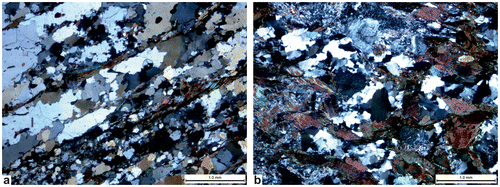
Different types of zircon and zones (cores and rims) were defined in the zircon population from the Kalabak formation using the CL images (Figure ). Zircons from the micaschist sample are generally transparent and colourless, sometimes brownish-yellow and rarely purple in colour. Most zircon crystals are subidiomorphic but a small subset is idiomorphic. Some of these have well-rounded shapes. The inner structures of zircons show variability but generally are dominated by magmatic zircons bearing oscillatory zoning. When zircon morphology is taken into consideration it is observed that some zircon grains were subjected to long-term weathering and/or transferring processes. Most of the grains are well rounded but some of them were carried apparently from closer distances, evident from their less-rounded and preserved prismatic crystal morphology. Measurements were performed on 175 points on the sample KB-5 from the Kalabak formation and 90–110% concordant ages were obtained on 107 points (Table ). In the classification of zircon sets, 206Pb/238U ages were used for the ones younger than 1 Ga; in contrast 207Pb/206Pb ages were used for the ones older than 1 Ga. 207Pb/206Pb are generally considered as ages having minimum lead losses (Meinhold, Kostopoulos, Reischmann, Frei, & BouDagher-Fadel, Citation2009). The geological time scale of Walker, Geissman, Bowring, and Babcock (Citation2012) is used as a stratigraphic reference for data interpretation.
Figure 4. Selected CL images of the zircon grains analysed from the Kalabak formation (KB-5). The zircons fall into three groups based on degree of roundness and crystal shapes. Locations of the LA-ICP-MS analysis in red spots and the corresponding ages are indicated.
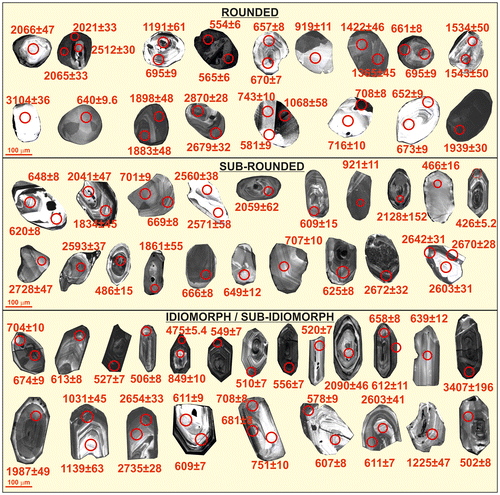
The youngest 426 ± 5.2 (206Pb/238U, 92.97% concordant, Th/U = .011) and oldest 3406.9 ± 195.7 (206Pb/207Pb, 95.98% concordant, Th/U = .430) zircon ages were taken in KB-5 micaschist sample. Nine points at 535 ± 13–426 ± 5.2 Ma age interval (8.4% Palaeozoic), 58 zircon points at 999 ± 11–549 ± 14 Ma age interval (54.21% Neoproterozoic), seven points at 1543 ± 50–1012 ± 200 Ma age interval 6.54% Mezoproterozoic), twenty points at 14 ± 58–1736 ± 123 Ma age interval (18.7% Palaeoproterozoic), and 13 points at 3406.9 ± 195.7–2512 ± 30 Ma age interval (12.15% Archean) were measured at zircons. Therefore, it can be concluded that 54.21% of zircon populations is concentrated in Neoproterozoic eras. Distribution of 58 zircons that give Neoproterozoic age is as follows: 16 points at 622 ± 7–549 ± 14 Ma age intervals (27.58% Ediacaran), 33 points at 841 ± 9–639 ± 24 Ma age interval (56.9% Cryogenian), and nine points at 999 ± 11–873 ± 9 Ma age interval (15.52% Tonian; Figure ). In addition, we found 17 zircon core ages from the Devonian metagranites cluster at 530.7–2281.8 Ma (Tables and ; Aysal et al., Citation2012).
Figure 5. Concordia diagram (upper) and probability density distributions (lower left 0–3500 Ma and lower right 400–1200 Ma) of the zircon ages obtained during this study from the Kalabak formation (KB-5). 206Pb/238U was used for ages < 1000 Ma and 207Pb/206Pb for ages > 1000 Ma in constructing the diagram. The inset in the upper diagram shows the enlarged portion of the Concordia diagram for the protolith ages from 426 to 841 Ma (Mid-Silurian to Cryogenian).
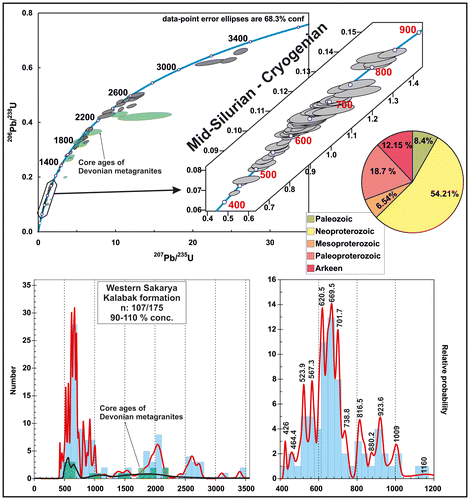
Table 3. Results of zircon LA-ICP-MS U-Pb age determinations of sample KR-9 from Karacabey metagranite (Geographic coordinate: 40°16′12.70″N, 28°20′40.33″E).
Table 4. Inherited zircon core ages from Devonian metagranites (Aysal et al., Citation2012).
The measured Th/U ratios range between .011 and 1.019 in 53 measurements which were performed in zircon rims and over growth zones, and were found in the range of 0.085–1.019 in 19 measurements which were performed in inherited cores. It is determined during the measurements that in the rim of eight zircon grains, Th/U ratios are > .1. Th/U ratios indicate that zircon grains are of felsic magmatic origin (Figure , Linnemann et al., Citation2011; Teipel et al., Citation2004).
Figure 6. Zircon Th/U ratio vs. age plot for the Kalabak formation (KB-5). The majority of the grains come from intermediate and magmatic sources; zircon fields are from Teipel et al. (Citation2004) and Linnemann et al. (Citation2011).

4.2. Dating of the Karacabey metagranite
Dated sample from the Karacabey metagranite (KR-9) is shown in Figure and geographic coordinate is given in Table . This sample is a fine- to medium-grained metagranite which has a brownish alteration colour. It displays a weakly developed foliation. It contains quartz, alkali feldspar, plagioclase, amphibole, and biotite as primary phases. Accessory phase is represented by zircon, apatite, and opaque minerals (Figure (b)).
Zircons from the Karacabey metagranite displaying magmatic oscillatory zoning, unique, prismatic shapes, and amber colour were analysed by using the LA-ICP-MS method (Figure ). Ages from 384 ± 9.4 to 443.2 ± 9.9 Ma were obtained on the magmatic oscillatory-zoned zircons/zircon rims, and 804 ± 10.5 Ma and 1961.9 ± 16.4 Ma ages were obtained in inherited cores (Table ). A Concordia age of 400.3 ± 1.4 Ma (i.e. Early Devonian) was obtained for the Karacabey metagranite, coinciding with the weighted mean 206Pb/238U age 399.3 ± 5.2 Ma of the analysed zircon grains (Figure ). Sunal (Citationin press) reported similar ages of 393.8 ± 2.7–395.9 ± 4.09 Ma from the Karacabey metagranite (in this issue).
4.3. Geochemistry of the Karacabey metagranite
The CIPW normative chemical classification scheme has been applied to the Karacabey metagranite, utilising the QAP diagram (Figure (a)) after Streckeisen (Citation1974), where the Karacabey metagranite samples were plotted in the fields of monzogranite and granodiorite. One sample is scattered away in the field of quartzmonzodiorite. Based on Shand’s (Citation1947) classification, it can be seen that two samples fall into metaluminous fields and all the rest are scattered in the peraluminous field (Figure (b)). Also, the ASI values vary between .91 and 1.63, and plot between I- and S-type granites. These samples have K2O contents ranging from 2.48 to 3.89% (with an average of 3.3%). They plot in the high-K calc-alkaline field on the K2O vs. SiO2 classification diagram of Peccerillo and Taylor (Citation1976) (Figure (c)). On one of the most commonly used tectonic discrimination diagrams for granitoids (i.e. Ta vs. Yb diagram of Pearce, Harrıs, & Tındle, Citation1984), the Karacabey metagranite samples clearly plot into the field of volcanic arc granites (Figure (d)).
Figure 9. (a) QAP nomenclature diagram (Streckeisen, Citation1974) with normative mineral compositions, (b) A/NK–A/CNK diagram (Shand, Citation1947) for the Karacabey metagranite, (c) K2O–SiO2 diagram (Peccerillo & Taylor, Citation1976), (d) Ta vs. Yb tectonic discrimation diagram of Pearce et al. (Citation1984).
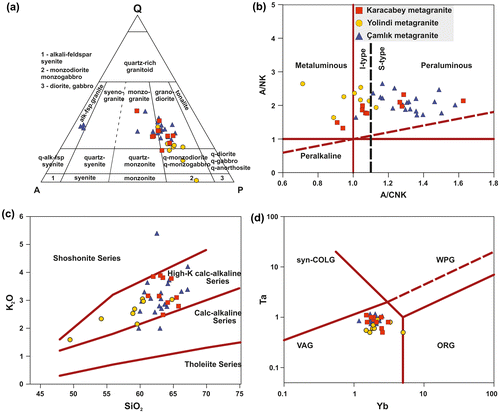
Multi-element spidergrams show results of Karacabey metagranite and the Devonian Çamlık and Yolindi metagranites (Aysal et al., Citation2012). N-MORB-normalised multi-element diagrams (Figure (a), (c), and (e)) indicate that all metagranitoid samples are enriched in LILEs (large ion lithophile elements; Sr, K, Rb, Ba, and Th) and, in a lesser extent, in LREEs (light rare earth elements; La, Ce, and Nd), but depleted in HFS elements (Tb, Ti, Y, and Yb). The decrease from Th to Ta and Nb is more profound than the decrease from La to Nd. On the other hand, Hf, Zr, and Sm form an almost horizontal trend. All Devonian metagranitoids in the region have similar patterns (Figure (a), (c), and (e)). In the Karacabey, Çamlık, and Yolindi metagranitoids, the aforementioned patterns represented by the distinct depletion in Ta and Nb with respect to the neighbouring LILE and LREEs can be interpreted as being the signature of either a volcanic arc or a post-collisional setting. In both cases, such a signature requires partial melting of the metasomatised mantle wedge in the stability field of rutile.
Figure 10. (a), (c), (e) N-MORB-normalised multi-element variation diagrams for the Karacabey, Yolindi and Çamlık metagranites. (b), (d), (f) Chondrite-normalised REE variation diagrams for the Karacabey, Yolindi, and Çamlık metagranites (normalisation values are from Sun & McDonough, Citation1989).
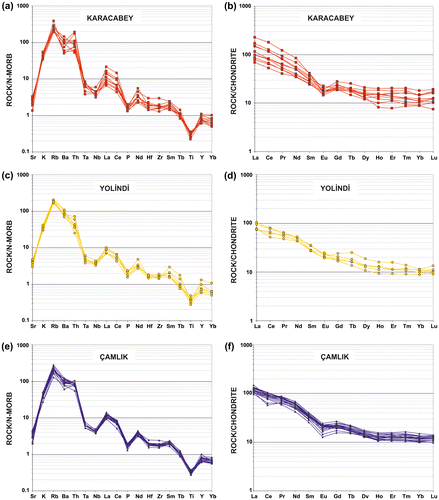
The Karacabey metagranite displays LREE-enriched patterns on the chondrite-normalised REE spidergrams (Figure (b, while HREE concentrations of most of the samples are one order higher than the chondrite values. All of the metagranite samples display upward concave patterns with slight but variable Eu anomalies with Eu/Eu* ranging from 0.54 to 0.89. Again, spider diagrams of the Karacabey, Yolindi, and Çamlık metagranites reveal similar chondrite-normalised patterns (Figure (b), (d), and (f)).
5. Discussion
5.1. Age and source regions of the Kalabak formation sample
The youngest 206Pb/238U detrital zircon age was measured as 426 ± 5.2 Ma (Middle Silurian), while younger ages vary between 457 ± 12 Ma (98.95% conc., Th/U = .171) and 466 ± 16 Ma (97.07% conc., Th/U = .018; Middle–Late Ordovician). Ordovician magmatic rocks are known to exist in the study area near Anatolide–Tauride platform and surrounding areas (Okay et al., Citation2008a; Okay, Satır, & Shang, Citation2008b; Özbey et al., Citation2012). Akbayram et al. (Citation2012) obtained 428–486 Ma zircon ages from Pamukova Complex. Because 8.4% of the analysed zircons are Palaeozoic in age and present a distribution of ages between 535 ± 13 and 426 ± 5.2 Ma, the Kalabak formation was probably deposited during a period between Ordovician and Silurian. Because there is an intrusive contact between the Kalabak formation and the Devonian metagranites, the Kalabak formation should be older than Early Devonian and possibly metamorphosed later under the conditions of low–middle pressure (Aysal et al., Citation2012) together with the Devonian metagranites.
Zircon populations of the Kalabak formation are dominated by Neoproterozoic ages (54.21%) and are concentrated on an age interval between Ediacaran and Cryogenian (850–542 Ma). In general, this interval presents similarities with the peri-Gondwana originated terrains which can be observed throughout the eastern and western Mediterranean regions alongside the northern Gondwana (Figures and ; Kydonakis et al., Citationin press; Meinhold et al., Citation2013; Ustaömer, Robertson, et al., Citation2012). Many Late Proterozoic–Early Palaeozoic-aged granitic rocks can be observed in near surroundings of study area in Menderes Massif (Bozkaya, Gürsu, & Cemal Göncüoglu, Citation2006; Bozkurt & Oberhänsli, Citation2001; Candan et al., Citation2011; Gessner, Collins, Ring, & Gungor, Citation2001, 2004; Koralay et al., Citation2004; Kröner & Şengör, Citation1990; Neubauer, Citation2002; Zlatkin, Avigad, & Gerdes, Citation2013), in Bolu Massif (Ayda Ustaömer et al., Citation2005), in Zonguldak – Karadere (Dean, Monod, Rickards, Demir, & Bultynck, Citation2000; Chen et al., Citation2002), in Bitlis Massif (Ustaömer P. A. et al., Citation2009, Ustaömer et al., Citation2011) and in Istranca Massif (Yılmaz-Şahin et al., Citationin press). These granitic rocks might have been the potential source of the Kalabak formation. The first zircon population is concentrated around 426–728 Ma ages interval can be observed in the basement of the central and eastern Sakarya Zone (Figure (b)–(d)), Istranca Massif, and Istanbul Zone (Figure (e) and (f)). This type of pattern typically has great similarities with those of the Cadomian–Avalonian terrains (Figure ).
Figure 11. Palaeogeographic reconstruction of the Cadomian–Avalonian active margin and related major peri-Gondwanan terranes at c. 570 Ma (Bahlburg et al., Citation2010; Linnemann et al., Citation2013 and references therein).
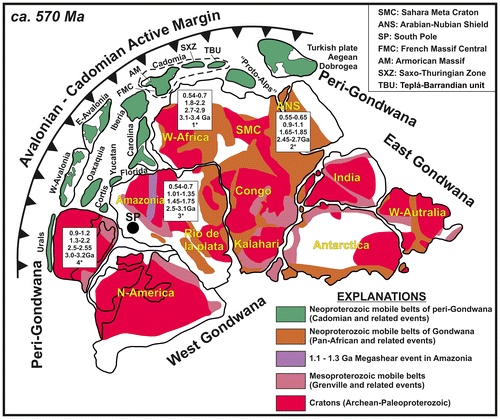
Figure 12. Detrital zircon age distributions of the analysed micaschist sample of the Kalabak formation (this study) and comparison with Avalonia, Cadomia, and other parts of Gondwana and potential source areas (data compilation from Linnemann et al., Citation2004; Ustaömer, Robertson, et al., Citation2012; and references therein).
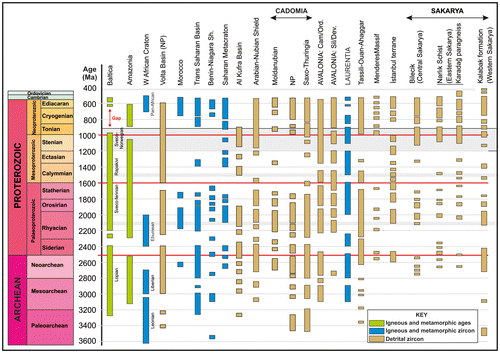
Figure 13. Age distribution patterns of detrital zircons for the samples discussed in the text (a) Kalabak formation from this study and inherited core ages of Devonian metagranites from in this study and Aysal et al., Citation2012); (b) central Sakarya (Ustaömer, Ustaömer et al., Citation2012); (c) and (d) eastern Sakarya (Ustaömer, Robertson, et al., Citation2012); (e) Istranca Massif (Natal’in et al., Citation2012); (f) Istanbul Zone (Ustaömer, Ustaömer, et al., Citation2009).
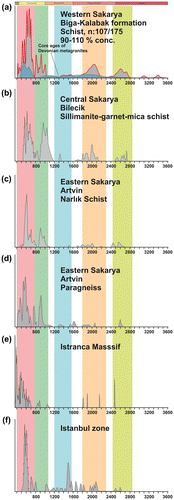
The second zircon population after this major peak is concentrated around 800–1000 Ma years. Although zircons with 800–1000 Ma age interval are more numerous in the central Sakarya basement with respect to western Sakarya, central Sakarya basement presents similar patterns to the eastern Sakarya basement (Figure (a)–(d)). These ages have lesser population in the Istranca Massif and Istanbul Zone, and do not have similarities with western Sakarya (Figure (a), (e) and (f)).
The third zircon population is concentrated around 1100–1550 Ma age interval in the Kalabak formation and the Devonian metagranite inherited zircon cores. This age interval has a critical importance for the source area. Such a zircon population with this age stage is rarely seen in central and eastern Sakarya basement. There is an important peak in the Ordovician sandstones (Ustaömer et al., Citation2009) in the Istanbul Zone.
The most remarkable zircon population after the Neoproterozoic ages is the 1700–2100 Ma year interval. Although 1700–2100 Ma-aged zircons have been determined in central Sakarya, the Istranca Massif, and Istanbul Zone, this period is relatively quiet in eastern Sakarya basement and includes lesser amounts of zircon. Although, Neoproterprozoic ages can dominantly be observed in the Arabian shield (Stern & Johnson, Citation2010).
Another zircon concentration in the Kalabak formation is remarked at 2400–2800 Ma years, and rarely observed in central and eastern Sakarya and Istanbul Zone; a peak draws attention with 2500 Ma value in the Istranca Massif. Lastly, there are zircon ages with 3100–3400 Ma years at three points. Zircon grains with 3100–3200 Ma age interval are absent in other zones.
If we take all these findings into consideration, it becomes obvious that the Kalabak formation has more similarities with the Avalon terrains. Remnants of the Avalon terrain have been determined by a number of researchers in the Istanbul Zone, not far away from the study area in Western Anatolia (Bozkurt, Winchester, Yiğitbas, & Ottley, Citation2008; Chen et al., Citation2002; Dean et al., Citation2000; Okay et al., Citation2008a, Citation2011; Ustaömer, Ustaömer, Gerdes, & Zulauf, Citation2011). Aysal et al. (Citation2012) argued that the Kalabak formation and the Devonian metagranites might be regarded as a part of a far-travelled exotic block, accreted to the basement of western Sakarya. Deformation and metamorphism of the Kalabak formation could have been developed in the Caledonian Zone after the collision of the Avalon terrains with the Baltica and Laurentia cratons, related to the closure of the Iapetus Ocean during the Ordovician–Silurian period (Aysal et al., Citation2012). Blueschist and eclogite blocks provide evidence for the often elusive Triassic subduction history of the Palaeotethys in the eastern Mediterranean area (Okay & Monié, Citation1997).
The Havran Unit in the western Sakarya Zone has been affected by a series of tectonic deformations that occurred in various periods including: closure of the Neotethyan Ocean during Late Cretaceous, collision of the Anatolide–Tauride platform with the Sakarya Zone (Şengör & Yılmaz, Citation1981) during Eocene, and the activity of the North Anatolian Transform Fault during Miocene (Şengör et al., Citation2005).
5.2. Petrogenesis of the metagranites
Devonian metagranites in the Havran Unit present same patterns on N-MORB-normalised multi-element diagrams. A significant enrichment can be observed in LILE (Sr, K, Rb, Ba, and Th) combined with a lesser enrichment in LREE (La, Ce, and Nd) on these diagrams and depletion in HFS elements (Tb, Ti, Y, and Yb) (Figure ). It can be observed in the Karacabey, Yolindi, and Çamlık metagranites that Ta and Nb are more depleted in comparison with the neighbouring LILE and LRE elements. However, they are enriched relative to N-MORB values. Aysal et al. (Citation2012) pointed out that this significant decrease in Ta and Nb recalls arc environment but inherited subduction components in collision zones cannot be ruled out. Besides, it should be noted that the exhaustion in HFS elements can also be explained by the mobility of these elements during the partial melting of mantle in the subduction zones (Figure (a), (c), and (e)). Similar patterns are also apparent on the chondrite-normalised spider diagrams of the Karacabey, Yolindi, and Çamlık metagranites. Although majority of the Karacabey metagranite samples present an upper concave pattern, they present Eu anomaly with variable rate. Eu/Eu* rates vary between .54 and .89. While these patterns can be explained by amphibole fractionation, negative Eu anomaly are linked to K-feldspar crystallisation (Figure (b), (d), and (f)).
Aysal et al. (Citation2012) argued on the basis of Sr/Nd isotope variations that the Devonian metagranites might have been generated by melting of the lower continental crust. In that study, alternative geodynamic settings for magma generation of these granitoids have been discussed and evaluated. Aysal et al. (Citation2012) put forward a model for the aforementioned metagranites (including the ones with a subduction component) that involves pounding of the mantle-derived basaltic magmas underneath the lower crust, resulting in a widespread partial crustal melting. On the basis of this evidence, Aysal et al. (Citation2012) suggested that these granites displaying a distinct subduction component might have been generated either in an ensialic arc setting or post-collisional tectonic environment. We argue that the same interpretation also applies to the Karacabey metagranite, because it bears a great amount of geochemical similarities with the Yolindi and Çamlık metagranites.
Crystallisation ages for some series of the metagranites in the Havran Unit can be listed as follows: 389.1 ± 2.6–401.5 ± 4.8 Ma Çamlık metagranite: 397.5 ± 1.4 Ma; Yolindi stock: 389.1 ± 2.6 Ma, Karaaydın stock: 401.4 ± 3.7 Ma; Güveylerobası stock: 401.5 ± 4.8 Ma, and Bayatlar stock: 401 ± 7.8 Ma; Okay et al., Citation2006, Citation1991; Aysal et al., Citation2012). The Concordia age obtained for the Karacabey metagranite is 400.3 ± 1.4 Ma. When both age and geochemistry of the units are taken into account, the Karacabey metagranite appears to have the same origin as that of the other metagranites in the Havran Unit.
On the basis of detrital zircon ages obtained from the Kalabak formation and the presence of the Devonian-aged plutonic rocks we argue that the Havran Unit might represent a terrain originated possibly from Avalonia.
6. Conclusion
Detrital zircon ages of the Kalabak formation are concentrated around 535 ± 13–426 ± 5.2 Ma, 750–542 Ma, 800–1000 Ma, 1100–1550 Ma, 1700–2100 Ma, 2400–2800 Ma, and 3100–3400 Ma intervals.
LA-ICP-MS U–Pb zircon dating yields 400.3 ± 1.4 Ma (Early Devonian) age for the Karacabey metagranite. This finding indicates that the Karacabey metagranite has a relation with other Devonian metagranites across the Biga Peninsula.
On the basis of the youngest zircon ages obtained from the Kalabak formation and the presence of the intrusive contact with the Devonian granites, we argue that the deposition age of the Kalabak formation should be older than Ordovician and younger than Devonian.
The new data and results we presented in this paper, in combination with correlations between similar units across the eastern Mediterranean region, indicate that the Kalabak formation and the Devonian metagranites (i.e. the Havran Unit) might be regarded as a part of the Avalonian terrains.
Acknowledgements
This work was supported by the Research Fund of Istanbul University, project numbers YADOP-16129 and 6888. We thank Prof. Dr Timur Ustaömer for inspiring us to write this manuscript. We would also like to thank Prof. Dr Sabah Yılmaz-Şahin for her insightful comments on the preliminary version of this manuscript. We thank chief editor Prof. Dr Erdin Bozkurt and two anonymous referees for their constructive comments on the manuscript. We are grateful to Tuncer Çiltaş of Arson Engineering Co. (Bursa) for logistical support during our field work.
References
- Akbayram, K., Okay, A. I., & Satır, M. (2012). Early Cretaceous closure of the Intra-Pontide Ocean in western Pontides (northwestern Turkey). Journal of Geodynamics, 65, 38–55.
- Aldanmaz, E., Pearce, J. A., Thirlwall, M. F., & Mitchell, J. G. (2000). Petrogenetic evolution of late Cenozoic, post-collision volcanism in western Anatolia, Turkey. Journal of Volcanology and Geothermal Research, 102, 67–95.10.1016/S0377-0273(00)00182-7
- Altunkaynak, Ş. (2007). Collision‐driven slab breakoff magmatism in northwestern Anatolia, Turkey. The Journal of Geology, 115, 63–82.10.1086/509245
- Altunkaynak, Ş., & Dilek, Y. (2006). Timing and nature of post collisional volcanism in Western Anatolia and geodynamic implications. Geological Society of America, 409, 321–351.
- Aysal, N., & Peytcheva, I. (2012, May 23–25). Geochemistry and U/Pb LA-ICP-MS zircon geochronology of Karacabey Pluton (Bursa, NW Turkey). 5th Geochemistry Symposium with International Participants (pp. 245–246), Denizli-Turkey, Abstract Book.
- Aysal, N., Ustaömer, T., Öngen, S., Keskin, M., Köksal, S., Peytcheva, I., & Fanning, M. (2012). Origin of the early-middle Devonian magmatism in the Sakarya Zone, NW Turkey: Geochronology, geochemistry and isotope systematics. Journal of Asian Earth Sciences, 45, 201–222.10.1016/j.jseaes.2011.10.011
- Bahlburg, H., Vervoort, J. D., & DuFrane, S. A. (2010). Plate tectonic significance of middle Cambrian and Ordovician siliciclastic rocks of the Bavarian facies, Armorican terrane assemblage, Germany – U–Pb and Hf isotope evidence from detrital zircons. Gondwana Research, 17, 223–235.10.1016/j.gr.2009.11.007
- Beccaletto, L., Bonev, N., Bosch, D., & Bruguier, O. (2007). Record of a Palaeogene syn-collisional extension in the north Aegean region: Evidence from the Kemer micaschists (NW Turkey). Geological Magazine, 144, 393–400.10.1017/S001675680700310X
- Bozkaya, Ö., Gürsu, S., & Göncüoglu, M. C. (2006). Textural and mineralogical evidence for a Cadomian tectonothermal event in the eastern Mediterranean (Sandıklı-Afyon area, western Taurides, Turkey). Gondwana Research, 10, 301–315.10.1016/j.gr.2006.04.009
- Bozkurt, E., & Oberhänsli, R. (2001). Menderes Massif (western Turkey): Structural, magmatic and metamorphic evolution. International Journal of Earth Sciences, 89, 697–708.
- Bozkurt, E., Winchester, J. A., Yiğitbaş, E., & Ottley, C. J. (2008). Proterozoic ophiolites and mafic–ultramafic complexes marginal to the İstanbul Block: An exotic terrane of Avalonian affinity in NW Turkey. Tectonophysics, 461, 240–251.10.1016/j.tecto.2008.04.027
- Candan, O., Koralay, O. E., Akal, C., Kaya, O., Oberhänsli, R., Dora, O. Ö., Konak, N., & Chen, F. (2011). Supra-Pan-African unconformity between core and cover series of the Menderes Massif/Turkey and its geological implications. Precambrian Research, 184, 1–23.10.1016/j.precamres.2010.09.010
- Cavazza, W., Okay, A. I., & Zattin, M. (2008). Rapid early-middle Miocene exhumation of the Kazdağ metamorphic core complex (Western Anatolia). International Journal of Earth Sciences, 98, 1935–1947.
- Chen, F., Siebel, W., Satır, M., Terzioğlu, N., & Saka, K. (2002). Geochronology of the Karadere basement (NW Turkey) and implications for the geological evolution of the İstanbul zone. International Journal of Earth Sciences, 91, 469–481.
- Condie, K. C., Belousova, E., Griffin, W. L., & Sircombe, K. N. (2009). Granitoid events in space and time: constraints from igneous and detrital zircon age spectra. Gondwana Research, 15, 228–242.10.1016/j.gr.2008.06.001
- Dean, W. T., Monod, O., Rickards, R. B., Demir, O., & Bultynck, P. (2000). Lower Palaeozoic stratigraphy and palaeontology, Karadere–Zirze area, Pontus Mountains, northern Turkey. Geological Magazine, 137, 555–582.10.1017/S0016756800004635
- Duru, M., Pehlivan, Ş., Dönmez, M. Ilgar, A., & Akçay, A.E. (2007). Geological map of the Balıkesir-i18 Quadrangle. General Directorate of Mineral Research and Exploration Report ( Report No: 97). Ankara.
- Duru, M., Pehlivan, Ş., Okay, A.İ., Şentürk, Y., & Kar, H. (2012). Biga Yarımadası’nın Tersiyer Öncesi Jeolojisi [Pre-Tertiary geology of the Biga Peninsula]. In E. Yüzer & G. Tunay (Eds.), Biga Yarımadası’nın Genel ve Ekonomik Jeolojisi, Editörler [General and economical geology of the Biga Peninsula, General Directorate of Mineral Research and Exploration] (pp. 7–74). Ankara: MTA Özel Yayın Serisi, No: 28.
- Ergül, E., Gözler, Z., Akçaören, F., & Öztürk, Z. (1986). MTA, 1/100000 Ölçekli Açınsama Nitelikli Türkiye Jeoloji Haritaları Serisi, Bandırma E-6 Paftası [Geological map of the Bandırma-E-6 Quadrangle. General Directorate of Mineral Research and Exploration Report] (p. 13). Ankara.
- Gessner, K., Collins, A. S., Ring, U., & Gungor, T. (2004). Structural and thermal history of poly-orogenic basement: U–Pb geochronology of granitoid rocks in the southern Menderes Massif, western Turkey. Journal of the Geological Society of London, 161, 93–101.
- Gessner, K., Piazolo, S., Güngör, T., Ring, U., Kröner, A., & Passchier, C. W. (2001). Tectonic significance of deformation patterns in granitoid rocks of the Menderes nappes, Anatolide belt, southwest Turkey. International Journal of Earth Sciences, 89, 766–780.10.1007/s005310000106
- Göncüoğlu, M. C., Dirik, K., & Kozlu, H. (1997). General characteristics of pre-Alpine and Alpine terranes in Turkey: Explanatory notes to the terrane map of Turkey. Annales Geologique de Pays Hellenique, 37, 515–536.
- Jackson, S. E., Pearson, N. J., Griffin, W. L., & Belousova, E. A. (2004). The application of laser ablation-inductively coupled plasma-mass spectrometry to in situ U–Pb zircon geochronology. Chemical Geology, 211, 47–69.
- Ketin, I. (1966). Anadolu’nun tektonik birlikleri [Tectonic units of Anatolia (Asia Minor)]. Journal of General Directorate of Mineral Research and Exploration, 66, 20–34.
- Kolodner, K., Avigad, D., McWilliams, M., Wooden, J. L., Weissbrod, T., & Feinstein, S. (2006). Provenance of north Gondwana Cambrian–Ordovician sandstone: U–Pb SHRIMP dating of detrital zircons from Israel and Jordan. Geological Magazine, 143, 367–391.10.1017/S0016756805001640
- Koralay, E. O., Dora, O., Chen, F., Satır, M., & Candan, O. (2004). Geochemistry and geochronology of orthogneisses in the Derbent (Alaşehir) Area, eastern part of the Ödemiş -Kiraz Submassif, Menderes Massif: Pan-African magmatic activity. Turkish Journal of Earth Sciences, 13, 37–61.
- Kröner, A., & Şengör, A. M. C. (1990). Archean and Proterozoic ancestry in late Precambrian to early Paleozoic crustal elements of southern Turkey as revealed by single-zircon dating. Geology, 18, 1186–1190.10.1130/0091-7613(1990)018<1186:AAPAIL>2.3.CO;2
- Krushensky, R. D., Akçay, Y., & Karaeğe, E. (1980). Geology of the Karalar-Yeşiller area, northwest Anatolia, Turkey. Geological Survey Bulletin, 1461, 72.
- Kydonakis, K., Kostopoulos, D., Poujol, M., Brun, J-P., Papanikolaou, D., & Paquette, J.-L. (in press). The dispersal of the Gondwana Super-fan System in the eastern Mediterranean: New insights from detrital zircon geochronology. Gondwana Research. Retrieved from http://dx.doi.org/10.1016/j.gr.2013.05.009
- Linnemann, U., McNaughton, N. J., Romer, R. L., Gehmlich, M., Drost, K., & Tonk, C. (2004). West African provenance for Saxo-Thuringia (Bohemian Massif): Did Armorica ever leave pre-Pangean Gondwana? – U-Pb-SHRIMP zircon evidence and the Nd-isotopic record. International Journal of Earth Sciences, 93, 683–705.10.1007/s00531-004-0413-8
- Linnemann, U., Ouzegane, K., Drareni, A., Hofmann, M., Becker, S., Gärtner, A., & Sagawe, A. (2011). Sands of West Gondwana: An archive of secular magmatism and plate interactions – A case study from the Cambro-Ordovician section of the Tassili Ouan Ahaggar (Algerian Sahara) using U-Pb-LA-ICP-MS detrital zircon ages. Lithos, 123, 188–203.10.1016/j.lithos.2011.01.010
- Linnemann, U., Gerdes, A., Hofmann, M., & Marko, I. (2013). The Cadomian Orogen: Neoproterozoic to early Cambrian crustal growth and orogenic zoning along the periphery of the West African Craton–Constraints from U-Pb zircon ages and Hf isotopes (Schwarzburg Antiform, Germany). Gondwana Research. Retrieved from doi.org/10.1016/j.precamres.2013.08.007
- Ludwig, K. R. (2003). User’s manual for Isoplot/Ex, version 3.0, a geochronological toolkit for Microsoft Excel. Berkeley, CA: Berkeley Geochronology Center Special Publication No. 4.
- Meinhold, G., Kostopoulos, D., Reischmann, T., Frei, D., & BouDagher-Fadel, M. K. (2009). Geochemistry, provenance and stratigraphic age of metasedimentary rocks from the eastern Vardar suture zone, northern Greece. Palaeogeography, Palaeoclimatology, Palaeoecology, 277, 199–225.10.1016/j.palaeo.2009.04.005
- Meinhold, G., Morton, A. C., & Avigad, D. (2013). New insights into peri-Gondwana paleogeography and the Gondwana super-fan system from detrital zircon U–Pb ages. Gondwana Research, 23, 661–665.10.1016/j.gr.2012.05.003
- Morag, N., Avigad, D., Gerdes, A., Belousova, E., & Harlavan, Y. (2011). Detrital zircon Hf isotopic composition indicates long-distance transport of North Gondwana Cambrian-Ordovician sandstones. Geology, 39, 955–958.10.1130/G32184.1
- Natal’in, A. N., Sunal, G., Satır, M., & Toraman, E. (2012). Tectonics of the Strandja Massif, NW Turkey: History of a long-lived arc at the northern margin of Paleo-Tethys. Turkish Journal of Earth Sciences, 21, 755–798.
- Neubauer, F. (2002). Evolution of Late Neoproterozoic to Early Paleozoic tectonic elements in central and Southeast European Alpine mountain belts: Review and synthesis. Tectonophysics, 352, 87–103.10.1016/S0040-1951(02)00190-7
- Okay, A. I. (1988). Geology and tectonic of the Çan-Yenice-Biga area, Turkish Petroleum Corporation Report number 2544 (Unpublished – in Turkish).
- Okay, A. I. (1989). Tectonic units and sutures in the Pontides, northern Turkey. In A. M. C. Şengör (Ed.), Tectonic evolution of the Tethyan region (pp. 109–116). Dordrecht: Kluwer.10.1007/978-94-009-2253-2
- Okay, A. I. (2000). Was the late Triassic orogeny in Turkey caused by the collision of an oceanic plateau? In E. Bozkurt, J. A. Winchester, & J. A. D. Piper (Eds.), Tectonics and magmatism in Turkey and surrounding area (pp. 25–41). London: Geological Society, Special Publications 173.
- Okay, A. I., & Göncüoğlu, M. C. (2004). The Karakaya complex: A review of data and concepts. Turkish Journal of Earth Sciences, 13, 77–95.
- Okay, A. I., & Monié, P. (1997). Early Mesozoic subduction in the eastern Mediterranean: Evidence from Triassic eclogite in northwest Turkey. Geology, 25, 595–598.10.1130/0091-7613(1997)025<0595:EMSITE>2.3.CO;2
- Okay, A. I., & Tüysüz, O. (1999). Tethyan sutures of northern Turkey. In B. Durand, L. Jolivet, F. Hovarth, & M. Séranne (Eds.), The Mediterranean Basins: Tertiary extension within the Alpine Orogen Tethyan Sutures of Northern Turkey (pp. 475–515). London: Geological Society, Special Publications 156.
- Okay, A. I., Siyako, M., & Burkan, K. A. (1990). Geology and tectonic evolution of the Biga Peninsula. TAPG Bulletin, 2/183–121.
- Okay, Aİ., Siyako, M., & Bürkan, K. A. (1991). Geology and tectonic evolution of the Biga Peninsula, Northwestern Turkey. İTÜ Bulletin, 44, 191–256.
- Okay, A. I., Satır, M., Tüysüz, O., Akyüz, S., & Chen, F. (2001). The tectonics of the Strandja Massif: Variscan and mid-Mesozoic deformation and metamorphism in the northern Aegean. International Journal of Earth Sciences, 90, 217–233.
- Okay, A. I., Monod, O., & Monié, P. (2002). Triassic blueschists and eclogites from northwest Turkey: Vestiges of the Paleo-Tethyan subduction. Lithos, 64, 155–178.10.1016/S0024-4937(02)00200-1
- Okay, A. I., Satır, M., & Siebel, W. (2006). Pre-Alpide orogenic events in the Eastern Mediterranean region. In D. G. Gee & R. A. Stephenson (Eds.), European lithosphere dynamics (pp. 389–405). London: Geological Society, Memoirs, 32.
- Okay, A. I., Bozkurt, E., Satır, M., Yiğitbaş, E., Crowley, Q. G., & Shang, C. K. (2008a). Defining the southern margin of Avalonia in the Pontides: Geochronological data from the late Proterozoic and Ordovician granitoids from NW Turkey. Tectonophysics, 461, 252–264.10.1016/j.tecto.2008.02.004
- Okay, A. I., Satır, M., & Shang, C. K. (2008b). Ordovician metagranitoid from the Anatolide-Tauride Block, northwest Turkey: Geodynamic implications. Terra Nova, 20, 280–288.10.1111/ter.2008.20.issue-4
- Okay, N., Zack, T., Okay, A. I., & Barth, M. (2011). Sinistral transport along the Trans-European Suture Zone: Detrital zircon–rutile geochronology and sandstone petrography from the carboniferous flysch of the Pontides. Geological Magazine, 148, 380–403.10.1017/S0016756810000804
- Özbey, Z., Ustaömer, T., Robertson, A. H. F., & Ustaömer, P. A. (2012). Tectonic significance of late Ordovician granitic magmatism and clastic sedimentation on the northern margin of Gondwana (Tavşanlı Zone, NW Turkey). Journal of the Geological Society, London, 170, 159–173.
- Pearce, J. A., Harrıs, N. B. W., & Tindle, A. G. (1984). Trace element discrimination diagrams for the tectonic interpretation of granitic rocks. Journal of Petrology, 25, 956–983.10.1093/petrology/25.4.956
- Peccerillo, A., & Taylor, S. R. (1976). Geochemistry of Eocene calc-alkaline volcanic rocks from the Kastamonu area, Northern Turkey. Contributions to Mineralogy and Petrology, 58, 63–81.10.1007/BF00384745
- Pehlivan, Ş., Duru, M., Kanar, F., & Kandemir, Ö. (2011). Geological map of the Bandırma–H20 quadrangle. General Directorate of Mineral Research and Exploration Report (Report No: 156). Ankara.
- Pickett, E. A., & Robertson, A. H. F. (1996). Formation of the late Palaeozoic–early Mesozoic Karakaya complex and related ophiolites in NW Turkey by Palaeotethyan subduction-accretion. Journal of the Geological Society, London, 153, 995–1009.10.1144/gsjgs.153.6.0995
- Pickett, E., & Robertson, A. H. F. (2004). Significance of the Triassic volcanogenic Nilufer unit for Paleotethys and the Karakaya suture zone in NW Turkey. Turkish Journal of Earth Sciences, 13, 97–143.
- Robertson, A. H. F., & Ustaömer, T. (2011). Testing alternative tectono-stratigraphic interpretations of the late Palaeozoic–early Mesozoic Karakaya Complex in NW Turkey: Support for an accretionary origin related to northward subduction of Palaeotethys. Turkish Journal of Earth Sciences, 21, 961–1007.
- Robertson, A. H. F., Ustaömer, T., Pickett, E., Collins, A. S., Andrew, T., & Dixon, J. E. (2004). Testing models of late Palaeozoic–early Mesozoic orogeny in Western Turkey: Support for an evolving open-Tethys model. Journal of the Geological Society, London, 161, 501–511.10.1144/0016-764903-080
- Şengör, A. M. C., & Yılmaz, Y. (1981). Tethyan evolution of Turkey, a plate tectonic approach. Tectonophysics, 75, 181–241.
- Şengör, A. M. C., Tüysüz, O., İmren, C., Sakınç, M., Eyidoğan, H., Görür, Naci, … Rangin, C. (2005). The North Anatolian Fault: A new look. Annual Review of Earth and Planetary Sciences, 33, 37–112.10.1146/annurev.earth.32.101802.120415
- Shand, S. J. (1947). Eruptive rocks, their genesis, composition, classification, and their relation to ore-deposits (3rd ed., pp. 488). New York, NY: Wiley.
- Sláma, J., Košler, J., Condon, D. J., Crowley, J. L., Gerdes, A., Hanchar, J. M., … Whitehouse, M. J. (2008). Plešovice zircon – A new natural reference material for U–Pb and Hf isotopic microanalysis. Chemical Geology, 249(1–2), 1–35.10.1016/j.chemgeo.2007.11.005
- Stern, R. J., & Johnson, P. (2010). Continental lithosphere of the Arabian Plate: A geologic, petrologic, and geophysical synthesis. Earth-Science Reviews, 101, 29–67.10.1016/j.earscirev.2010.01.002
- Strachan, R. A., Collins, A. S., Buchan, C., Nance, R. D., Murphy, J. B., & D’Lemos, R. S. (2007). Terrane analysis along a Neoproterozoic active margin of Gondwana: İnsights from U-Pb zircon geochronology. Journal of the Geological Society, London,164, 57–60.10.1144/0016-76492006-014
- Streckeisen, A. (1974). Classification and nomenclature of plutonic rocks recommendations of the IUGS subcommission on the systematics of igneous rocks. Geologische Rundschau, 63, 773–786.10.1007/BF01820841
- Sun, S. S., & McDonough, W. F. (1989). Chemical and isotopic systematics of oceanic basalts: Implications for mantle composition and processes. In A. D. Saunders & M. J. Norry (Eds.), Magmatism in the ocean basins (pp. 313–345). London: Geological Society Special Publication 42.
- Sunal, G. (In press). Devonian magmatism in the western Sakarya Zone, Karacabey Region, NW Turkey. Geodinamica Acta. doi:10.1080/09853111.2013.858947
- Sunal, G., Natal’in, B. A., Satır, M., & Toraman, E. (2006). Paleozoic magmatic events in the Strandja Massif, NW Turkey. Geodinamica Acta, 19, 281–298.
- Sunal, G., Satır, M., Natal’in, B. A., & Toraman, E. (2008). Paleotectonic position of the Strandja Massif and surrounding continental blocks based on zircon Pb-Pb age studies. International Geology Review, 50, 519–545.10.2747/0020-6814.50.6.519
- Talavera, C., Montero, P., Martínez Poyatos, D., & Williams, I. S. (2012). Ediacaran to lower Ordovician age for rocks ascribed to the Schist–Graywacke Complex (Iberian Massif, Spain): Evidence from detrital zircon SHRIMP U–Pb geochronology. Gondwana Research, 22, 928–942.10.1016/j.gr.2012.03.008
- Teipel, U., Eichhorn, R., Loth, G., Rohrmüller, J., Höll, R., & Kennedy, A. (2004). U-Pb SHRIMP and Nd isotopic data from the western Bohemian Massif (Bayerischer Wald, Germany): Implications for Upper Vendian and Lower Ordovician magmatism. International Journal of Earth Sciences, 93, 782–801.10.1007/s00531-004-0419-2
- Topuz, G., Altherr, R., Siebel, W., Schwarz, W. H., Zack, T., Hasözbek, A., … Şen, C. (2010). Carboniferous high-potassium I-type granitoid magmatism in the Eastern Pontides: The Gümüşhane pluton (NE Turkey). Lithos, 116, 92–110.10.1016/j.lithos.2010.01.003
- Ustaömer, P. A. (1999). Pre-early Ordovician Cadomian arc-type granitoids, the Bolu Massif, west Pontides, northern Turkey: Geochemical evidence. International Journal of Earth Sciences, 88, 2–12.
- Ustaömer, P. A., Mundil, R., & Renne, P. R. (2005). U/Pb and Pb/Pb zircon ages for arc-related intrusions of the Bolu Massif (W Pontides, NW Turkey): Evidence for Late Precambrian (Cadomian) age. Terra Nova, 17, 215–223.10.1111/ter.2005.17.issue-3
- Ustaömer, P. A., Ustaömer, T., Collins, A. S., & Robertson, A. H. F. (2009). Cadomian (Ediacaran–Cambrian) arc magmatism in the Bitlis Massif, SE Turkey: Magmatism along the developing northern margin of Gondwana. Tectonophysics, 475, 99–112.
- Ustaömer, P. A., Ustaömer, T., Gerdes, A., & Zulauf, G. (2011). Detrital zircon ages from a lower Ordovician quartzite of the İstanbul exotic terrane (NW Turkey): Evidence for Amazonian affinity. International Journal of Earth Sciences, 100, 23–41.10.1007/s00531-009-0498-1
- Ustaömer, T., Robertson, A. H. F., Ustaömer, P. A., Gerdes, A., & Peytcheva, I. (2012). Constraints on Variscan and Cimmerian magmatism and metamorphism in the Pontides (Yusufeli–Artvin area), NE Turkey from U-Pb dating and granite geochemistry. Geological Society, London, Special Publications, 372, 49–74.
- Ustaömer, P. A., Ustaömer, T., & Robertson, A. H. F. (2012). Ion probe U-Pb dating of the central Sakarya basement: A peri-Gondwana terrane intruded by late lower Carboniferous subduction/collision-related granitic rocks. Turkish Journal of Earth Sciences, 21, 905–932.
- Walker, J. D., Geissman, J. W., Bowring, S. A., & Babcock, L. E., & Compilers. (2012). Geologic time scale v. 4.0. Geological Society of America. doi:10.1130/2012.CTS004R3C
- Yılmaz-Şahin, S.Aysal, N., Güngör, Y. Peytcheva, I. Neubauer, F. (in press). Geochemistry and U-Pb zircon geochronology of metagranites in Istranca (Strandja) Zone, NW Pontides, Turkey: Implications for the geodynamic evolution of Cadomian orogeny. Gondwana Research. doi:10.1016/j.gr.2013.07.011
- Zlatkin, O., Avigad, D., & Gerdes, A. (2013). Evolution and provenance of Neoproterozoic basment and Lower Paleozoic siliciclastic cover of the Menderes Massif (vestern Taurides): Coupled U-Pb-Hf zircon isotope geochemistry. Gondwana Research, 23, 682–700.

